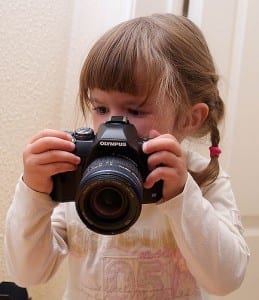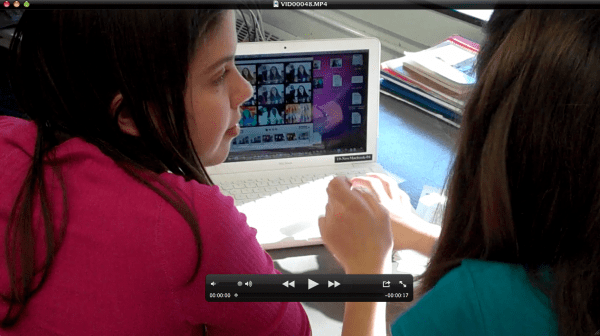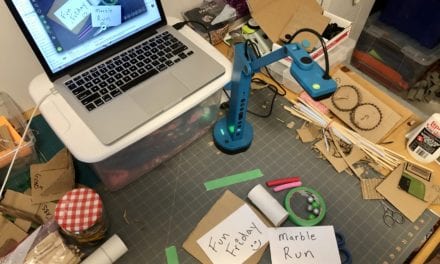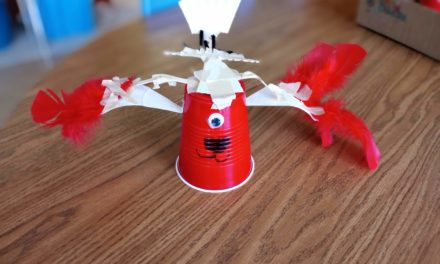Schools and many homes today are equipped with at the very least some rudimentary form of media-making device. My own two-year old loves grabbing the iPad and going for the camera icon, clumsily taking pictures of her thumb, her lap and sometimes Lucy the Cat. And although she hates having the lens turned on her, she loves watching the result, with her favourite clips and photos the ones where she is frantically trying to wrest the tablet from my hands. These she will watch or browse through over and over again, relishing each squeal of anger and looking to me with delight. There is little doubt that my daughter is growing up in a world where the meaning we make is multi-modal (I don’t want to use the word multimedia, with its associations of presentations and complicated playback hardware). Where we respond to a video in a social media space with a photograph or a song that sparks comments, weaving a tapestry of meaning from the various modes.
Children make meaning because it is what we do as humans. Give us a stick and we’ll look for a surface to mark. We have a desire to tell stories and have stories told to us. In schools, the intertwined acts of reading and writing are a matter of course for all of us educators. We know the intricate dance of meaning hidden in the mechanics of learning to decipher words and sentences and shaping one’s own letters in turn. Not only is literacy, the ability to both read and write, a cornerstone of our education system, but we have spent decades perfecting how and when we introduce young learners to various aspects of reading and writing. Although we value reading and writing somewhat above other means of communicating, this does not mean that we should be avoiding teaching students how to ‘read’ complex media texts or how to craft intricate messages of their own.
In the past, educators who introduced media into their classrooms often focused on media critique. They went looking for biases, hidden meanings and subliminal messages, no doubt as a reaction to insidious advertising and news media techniques. While there is no harm to this approach, it is certainly a single-faceted view of media education, as though teaching someone only how to read, and not how to write. For is it not the very act of writing that brings to light a lot of what we read? The creating of characters, the choosing of words to convey emotion or lack thereof, the structuring and pacing of sentences…are these not the acts that allow us to fully appreciate what we read? It is the same with media: the act of making media, of crafting a message from beginning to end, inevitably results in some new awareness, some new understanding of how media messages impact us.
Making media is about making meaning through images, characters, sound, words and motion. Like with reading and writing, there are discrete and often quite mechanical skills to be taught: as we learn how to grip a pencil, we also learn how to hold a camera and press the shutter. As we begin expressing our ideas in sentences, so too can we be taught to express our ideas in a series of shots or movements across the screen. As we play with sentence length and the legato or staccato of certain words, so too can we learn when to effectively deploy a slow pan or zoom in. And as we become inspired by what we read and want to try some of the writing devices for ourselves, we can also find inspiration in the media messages that move us.
The issue, often, is that making media is time consuming. But this is only part of the truth. When children begin writing at first, we do not expect them to come up with pages filled with writing on their own. They illustrate key words, they invent spelling, they tell their story aloud. These approaches are also effectively used for making media. Students can take photographs of events going on in the classroom, such as a sprouting bean or a special visitor. They can also record oral reactions to what they watch or read. They can create animations that play with colours and shapes. Just as we do not expect them to write an essay in Cycle 1, so too should we cut them some slack when it comes to media production. Cut them some slack, yes, but provide them with daily opportunities to hone the craft of making media. So when they do take a photograph or record their voice or make an animation, we can take a look at form along with content. Is the photograph in focus? Is the framing good? Is it a tight enough/wide enough shot that you can see what is most important? Is the recording clear? Are there any distracting background noises? Is the animation too fast? Little by little, over time, students learn the craft of making media by taking small regular steps. Like the layers of literacy that begin with the first board books and lullabies and continue into the school years, the skills involved in ‘reading’ and ‘writing’ media texts need to be honed over time.
And you, how are you using media with your students? How are you working with teachers to make media with students?
Here are some highlights from the Quebec scene:
Tuned into Culture (Culture à l’écoute)
http://www.learnquebec.ca/en/content/pedagogy/media_production/podcasting/baladoweb.html
Animation on the LEARN website
http://www.learnquebec.ca/en/content/pedagogy/media_production/animation/index.html
Free Animation Software Giveaway – until January 31, 2012
http://www.toonboom.com/doodle







Very interesting post Sylwia. I especially liked the part about how writing is exactly how we improve reading skills. I think of how the different adults I know who write “for a purpose” (academics, fiction writers, and some friends who are journalists) really understand the craft of others who write in the same genre. They learn the specific tricks I think, and then recognize the variations on the tricks others use too. One thing I would add though is that they learn to work “quickly” in their specific chosen field only because of a certain focus. I am thinking about what you said when you objected to the notion that working with media has to be time consuming. No, it doesn’t have to, but in my experience generally it is, usually because there are so many different technologies to continually learn (because they are continually changing). Again here I think the trick is to learn methods associated with one focus or purpose, learn them well so that it becomes efficient and comfortable to work in a particular technology. Once that happens then media work can be natural and expressive.
Good point about having a single focus in order to develop fluency. I agree that we tend to jump around from tool to tool and task to task. Are you saying that if we were to channel media production into a single facet per school year (?), we would go about educating our students in a more efficient manner? I’d like to hear more about this idea.